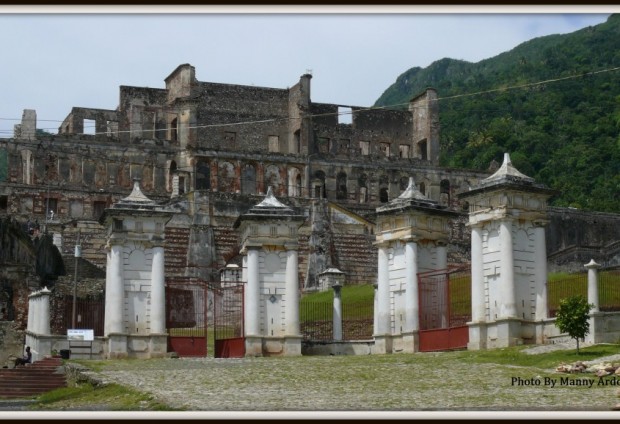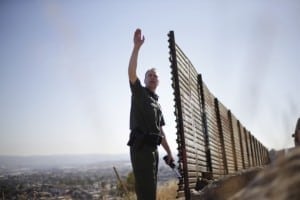For the US, “homeland security” is hardly limited to the homeland.
One of those CESFRONT (Specialized Border Security Corps) guards, carrying an assault rifle, is walking six young Haitian men back to the main base in Dajabon, which is painted desert camouflage as if it were in a Middle Eastern war zone.
If the scene looks like a five-and-dime version of what happens on the US southern border, that’s because it is. The enforcement model the Dominican Republic uses to police its boundary with Haiti is an import from the United States.
CESFRONT itself is, in fact, an outgrowth of a US effort to promote “strong borders” abroad as part of its Global War on Terror. So US Consul-General Michael Schimmel told a group from the Columbia Law School Human Rights Clinic in the Dominican Republic back in 2008, according to an internal report written by the law students along with the Dominican immigrant solidarity organization Solidaridad Fronteriza. The US military, he added, was training the Dominican border patrol in “professionalism.”
Schimmel was explaining an overlooked manifestation of US imperial policy in the post-9/11 era. Militarized borders are becoming ever more common throughout the world, especially in areas of US influence.
CESFRONT’s Dajabon commander is Colonel Juan de Jesus Cruz, a stout, Napoleonic figure with a booming voice. Watching the colonel interact with those detained Haitian teenagers was my first brush with how Washington’s “strong borders” abroad policy plays out on the ground. The CESFRONT base in Dajabon is located near the Massacre River that divides the two countries. Its name is a grim reminder of a time in 1937 when Dominican forces slaughtered an estimated 20,000 Haitians in what has been called the “twentieth century’s least-remembered act of genocide.” That act ensured the imposition of a 227-mile boundary between the two countries that share the same island.
As rain falls and the sky growls, Cruz points to the drenched young Haitians and says a single word, “ilegales,” his index finger hovering in the air. The word “illegals” doesn’t settle well with one of the teenagers, who glares at the colonel and replies defiantly, “We have come because of hunger.”
His claim is corroborated by every report about conditions in Haiti, but the colonel responds, “You have resources there,” with the spirit of a man who relishes a debate.
The teenager, who will undoubtedly soon be expelled from the Dominican Republic like so many other Haitians (including, these days, people of Haitian descent born in the country), gives the colonel a withering look. He’s clearly boiling inside. “There’s hunger in Haiti. There’s poverty in Haiti. There is no way the colonel could not see that,” he tells Cruz. “You are right on the border.”
This tense, uneasy, and commonplace interaction is one of countless numbers of similar moments spanning continents from Latin America and Africa to the Middle East and Asia. On one side, a man in a uniform with a gun and the authority to detain, deport, or sometimes even kill; on the other, people with the most fundamental of unmet needs and without the proper documentation to cross an international boundary. Such people, uprooted, in flight, in pain, in desperate straits, are today ever more commonly dismissed, if they’re lucky, as the equivalent of criminals, or if they aren’t so lucky, labeled “terrorists” and treated accordingly.
In a seminal article “Where’s the US Border?,” Michael Flynn, founder of the Global Detention Project, described the expansion of US “border enforcement” to the planet in the context of the Global War on Terror as essentially a new way of defining national sovereignty. “US border control efforts,” he argued, “have undergone a dramatic metamorphosis in recent years as the United States has attempted to implement practices aimed at stopping migrants long before they reach US shores.”
In this way, borders are, in a sense, being both built up and torn down. Just as with the drones that, from Pakistan to Somalia, the White House sends across national boundaries to execute those it has identified as our enemies, so with border patrolling: definitions of US national “sovereignty,” including where our own borders end and where our version of “national” defense stretches are becoming ever more malleable. As Flynn wrote, although “the US border has been hardened in a number of ways—most dramatically by building actual walls—it is misleading to think that the country’s efforts stop there. Rather the US border in an age dominated by a global war on terrorism and the effects of economic globalization has become a flexible point of contention.”
In other words, “hard” as actual US borders are becoming, what might be called our global, or perhaps even virtual, borders are growing ever more pliable and ever more expansive—extending not only to places like the Dominican Republic, but to the edges of our vast military-surveillance grid, into cyberspace, and via spinning satellites and other spying systems, into space itself.
Back in 2004, a single sentence in the 9/11 commission report caught this changing mood succinctly: “9/11 has taught us that terrorism against American interests ‘over there’ should be regarded just as we regard terrorism against Americans ‘over here.’ In this same sense the American homeland is the planet.”
New World Border
Washington’s response to the 2010 Haitian earthquake provides one example of how quickly a mobile US border and associated fears of massive immigration or unrest can be brought into play.
In the first days after that disaster, a US Air Force cargo plane circled parts of the island for five hours repeatedly broadcasting in Creole the prerecorded voice of Raymond Joseph, Haiti’s ambassador to the United States.
“Listen, don’t rush [to the United States] on boats to leave the country,” he said. “If you do that, we’ll all have even worse problems. Because I’ll be honest with you: if you think you will reach the US and all the doors will be wide open to you, that’s not at all the case. And they will intercept you right on the water and send you back home where you came from.”
That disembodied voice from the heavens was addressing Haitians still stunned in the wake of an earthquake that had killed up to 316,000 people and left an additional one million homeless. State Department Deputy Spokesman Gordon Duguid explained the daily flights to CNN this way: “We are sending public service messages… to save lives.” Meanwhile, the Department of Homeland Security (DHS) quickly dispatched 16 Coast Guard cutters to patrol Haitian waters, blocking people from leaving their devastated island. DHS authorities also cleared space in a 600-bed immigration detention center in Miami, and at the for-profit Guantanamo Bay Migrations Operation Center (run by the GEO Group) at the infamous US base in Cuba.
In other words, the US border is no longer static and “homeland security” no longer stays in the homeland: it’s mobile, it’s rapid, and it’s international.
Maybe this is why, last March, when I asked the young salesmen from L-3 Communications, a surveillance technology company, at the Border Security Expo in Phoenix if they were worried about the sequester—Congress’s across-the-board budget cuts that have taken dollars away from the Pentagon and the Department of Homeland Security—one of them simply shrugged. “There’s the international market,” he said as if this were almost too obvious to mention.
He was standing in front of a black globular glass eye of a camera they were peddling to security types. It was draped with desert camouflage, as if we were out in the Arizona borderlands, while all around us you could feel the energy, the synergy, of an emerging border-industrial complex. Everywhere you looked government officials, Border Patrol types, and the representatives of private industry were meeting and dealing in front of hundreds of booths under the high ceilings of the convention center.
On the internationalization of border security, he wasn’t exaggerating. At least 14 other countries ranging from Israel to Russia were present, their representatives browsing products ranging from miniature drones to Glock handguns. And behind the bustle of that event lay estimates that the global market for homeland security and emergency management will reach $544 billion annually by 2018. “The threat of cross-border terrorism, cyber-crime, piracy, drug trade, human trafficking, internal dissent, separatist movements has been a driving factor for the homeland security market,” the market research company MarketsandMarkets reported, based on a study of high-profit security markets in North America, Europe, and Asia.
This booming business thrives off the creation of new border patrols globally. The Dominican Republic’s CESFRONT, for instance, did not exist before 2006. That year, according to Dominican Today, a group of “US experts”reported that there were “a series of weaknesses that will lead to all kinds of illicit activities” on the Haitian-Dominican border. The US team recommended that “there should be helicopters deployed in the region and [that] there be a creation of a Border Guard.” A month after their report appeared, that country, by Dominican presidential decree, had its own border patrol.
By 2009, the new force had already received training, funding, and resources from a number of US agencies, including the Border Patrol itself. Somehow, it seems that what the US consulate calls “strong borders” between the Dominican Republic and the hemisphere’s poorest country has become an integral part of a terror-obsessed world.
When I met with Colonel Orlando Jerez, a CESFRONT commander, in the border guard agency’s headquarters in the Dominican capital Santo Domingo, I noticed that on his desk he had a US Border Patrol model car, a replica of the one that agency sponsored on the NASCAR circuit from 2006 to 2008 in an attempt to recruit new agents. Along the side of the shiny box that held it was this mission statement: “We are the guardians of the nation’s borders, we are America’s frontlines.”
When I asked Jerez whether CESFRONT had a relationship with our Border Patrol, he replied without a second’s hesitation, “Of course, they have an office in the US embassy.”
Jerez is not alone. Washington’s global boundary-building, its promotion of those strong borders, and its urge to preempt “terrorism against American interests ‘over there,’” as the 9/11 commission report put it, are spreading fast. For example, the Central American Regional Security Initiative, a $496 million US counter-drug plan launched in 2008, identifies “border security deficiencies” among Central American countries as a key problem to be dealt with ASAP. So the US Border Patrol has gone to Guatemala and Honduras to help train new units of border guards.
As in Central America, border patrolling’s most vibrant markets are in places that Washington sees as far too chaotic, yet where its economic and political interests reside. For six years now, US Customs and Border Protection (CBP) has sent its agents, clad in brown jumpsuits, to Iraq’s borderlands to assist that government in the creation of a force to police its “porous” borders (where chaos has indeed been endemic since the 2003 US invasion and subsequent occupation of the country). US boundary-building efforts began there in 2004 with an operation labeled “Phantom Linebacker” in which 15,000 border guards were trained to patrol in—as the name of the operation indicates—the spirit of American football.
In 2012, agent Adrian Long told Frontline, the CBP’s in-house magazine, that his agency trains Iraqis “in Border Patrol techniques like cutting sign, doing drags, setting up checkpoints and patrols.” Long was repeating the same lingo so often heard on the US-Mexican border, where agents “cut sign” to track people by their trail marks and do “drags” to smooth out dirt roads so they can more easily see the footprints of any “border intruders.” In Afghanistan, Border Patrol agents are similarly training forces to police that country’s 3,436 miles of frontiers. In 2012, during one training session, an Afghan policeman even turned his gun on two CBP agents in an “insider attack,” killing them and seriously injuring a third.
Around soccer’s World Cup, which South Africa hosted in 2010, CBP assisted that government in creating a Customs and Border Control Unit tasked with “securing South Africa’s borders while facilitating the movement of goods and people,” according to CBP’s Africa and Middle East branch country manager for South Africa Tasha Reid Hippolyte. South Africa has even brought itsmilitary special forces into the border patrolling process. Near the Zimbabwean border, its militarized guards were using a triple barrier of razor wire and electric fencing that can be set to offer shocks ranging from mild to deadly in their efforts to stop border crossers. Such equipment had not been used in that country since the apartheid-era.
In many cases, the US is also training border forces in the use of sophisticated surveillance systems, drones, and the construction of fences and barriers of various kinds, largely in attempts to clamp down on the movement of people between poorer and richer countries. More than 15,000 foreign participants in more than 100 countries have taken part in CBP training sessions since October 2002. It is little wonder, then, that an L-3 Communications sales rep would shrug off the constraints of a shrinking domestic national security budget.
Meanwhile, US borders are functionally being stretched in all sorts of complex ways, even across the waters. As Michael Schmidt wrote in the New York Times in 2012, for example, “An ocean away from the United States, travelers flying out of the international airport here on the west coast of Ireland are confronting one of the newest lines of defense in the war on terrorism: the United States border.” There, at Shannon International Airport, Department of Homeland Security officials set up the equivalent of a prescreening border checkpoint for air travelers.
Whether it is in your airports or, as in Haiti’s case, in the international waters around your country, the US border is on its way to scrutinize you, to make sure that you are not a threat to the “homeland.” If you don’t meet Washington’s criteria for whatever reason, you will be stopped, forcibly if necessary, from entering the United States, or even in many cases from travelling anywhere at all.
CBP attachés are now detailed to US embassies in Brazil, Mexico, Kenya, South Africa, Italy, and Canada, among many other countries. According to an agency publication, Customs and Border Protection Today, they have beentasked with the mission of keeping “terrorists and their weapons from our shores,” as well as providing technical assistance, “fostering secure trade practices, and strengthening border authority principles.” The anonymous writer then typically, if floridly, describes “our country’s border” as “the armor of the body politic; it protects the systems and infrastructures that function within. Knives pierce armor and can jeopardize the body—so we sheath them; keep them at bay; and demand accountability from those who use them.”
As CBP Commissioner Robert Bonner put it in 2004, the US is “extending our zone of security, where we can do so, beyond our physical borders—so that American borders are the last line of defense, not the first line of defense.”
Perhaps this is why few here batted an eye when, in 2012, Assistant Secretary of International Affairs and Chief Diplomatic Officer for the Department of Homeland Security Alan Bersin flatly declared, “The Guatemalan border with Chiapas is now our southern border.”
On the Edge of Empire
As dusk falls and the rainstorm ends, I walk along the river’s edge where those Dominican border patrol agents are still sitting, staring into Haiti. Considering that US forces occupied the Dominican Republic and Haiti numerous times in the previous century, it’s easy to imagine why Washington’s border chieftains consider this sad, impoverished spot part of our “backyard.” Not far from where I’m walking is the Codevi industrial free trade zone that straddles the border. There, Haitian workers churn out jeans mainly for Levi Strauss and the North American market, earning less than three dollars a day.
I approach one of the CESFRONT guards in his desert camouflage uniform. He’s sitting with his assault rifle between his legs. He looks beyond bored—no surprise since being suspicious of people who happen to be on the other side of a border can be deadly tedious work.
Please support our journalism. Get a digital subscription for just $9.50!
Diaz, as his name patch identifies him, tells me that his shift, which runs from 6 p.m. to midnight, is normally eventless because Haitians rarely cross here. When I explain where I’m from, he wants to know what the US-Mexico border looks like. I tell him about the fencing, the sensors, the cameras, and the agents everywhere you look. I ask if he has ever met agents of the US Border Patrol.
“Of course!” he says in Spanish, “there have been training sessions.”
Then I ask if terrorists are crossing this border, which is the reason the US consulate in Santo Domingo gives for supporting the creation of CESFRONT.
Diaz looks at me as if I’m nuts before offering an emphatic “No!”
No surprise there either. CESFRONT, like similar outfits proliferating globally, isn’t really about terrorism. It’s all about Haiti, one of the poorest countries on the planet. It is a response to fears of the mass movement of desperate, often hungry, people in the US sphere of dominance. It is the manifestation of a new vision of global geopolitics in which human beings in need are to be corralled, their free movement criminalized, and their labor exploited.
With this in mind, the experimental border control technologies being tested along the US-Mexican boundary line and the border-industrial complex that has grown up around it are heading abroad in a major way. If Congress finally passes a new multi-billion dollar border-policing package, its effects will be felt not only along US borders, but also at the edges of its empire.
Politico., http://www.thenation.com/article/177253/wait-what-are-us-border-patrol-agents-doing-dominican-republic




No comments yet.